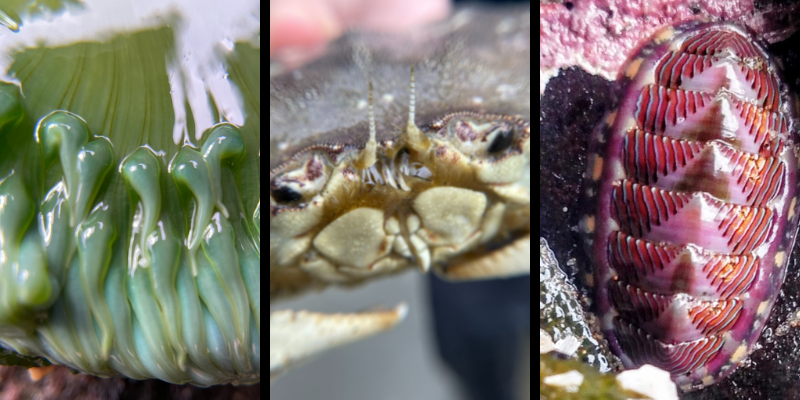
In 2022, the Oregon Marine Reserves Program, managed by the Oregon Department of Fish & Wildlife, celebrated a decade of conservation, scientific research, and connecting community members to these biodiverse coastal ecosystems.
The marine reserves system is the first long-term nearshore ocean conservation and monitoring program executed by the state. The program was initially started in 2009, with harvest restrictions going into effect at the first two marine reserve sites in 2012.
“We’re generating new knowledge that’s relevant to making better management decisions,” says Dr. Lindsay Aylesworth, ODFW’s Marine Reserves Program leader. That includes “trying to understand how ocean conditions are changing, how biological communities are changing, how fisheries are changing, and what’s driving those changes, and then identifying what we can do about it.”
Cape Falcon Marine Reserve—the centerpiece of North Coast Land Conservancy’s marine program—is the northernmost marine reserve site, located just off Oswald West State Park. It is also the youngest, as monitoring began in 2014 and restrictions were implemented in 2016. Along with the reserve, the site includes two marine protected areas (MPAs).
“There’s a really good land-sea connection at Cape Falcon,” Lindsay says, adding that the importance and popularity of Oswald West translate into “a high recreational value,” with people using the beaches for surfing, tide-pool activities, walking and swimming. “It does provide an access point for a lot of people to be able to enjoy the beauty of the marine reserve.”
Scientific Research in the Marine Reserves
The marine reserve sites are often described as “living laboratories,” dedicated to conservation and scientific research. ODFW scientists and partners gather data, monitor ecological changes, and explore the economic, social, and cultural dynamics of the Oregon coast and coastal communities in relation to marine resources.
“The marine reserves were put in place for us to protect biodiversity and for us to learn more about these nearshore, biological communities, and we’re doing that, and we’re doing that in Cape Falcon and learning some cool things,” Lindsay says.
A variety of research tools are used to monitor the marine reserves, and they’re tailored to each site’s unique characteristics. For example, Cape Falcon Marine Reserve is dominated by soft-bottom habitats. It also includes some small, isolated, low-relief patches of rock situated in shallower waters.
Through long-term monitoring, scientists have documented changes in key species and ecological communities in Oregon’s coastal environments and have shown the marine reserves system is protecting a variety of fish and invertebrate species. They are also gaining an understanding of how these ecosystems are being affected by climate change and other threats, such as ocean acidification.
“The marine reserves are helping to strengthen the health of our ocean,” Lindsay says. “Part of that is because we have data that is being incorporated into other nearshore management decisions.”
One of the observations to come out of Cape Falcon in the past few years is that the site includes the most catches of buffalo sculpin (Enophrys bison) of any marine reserve. Also, when there is a strong upwelling, there are higher catch rates—a response not observed in data from other sites. Additionally, eight sunflower sea stars have been observed after Sea Star Wasting Disease.
“The fact we have these observations from Cape Falcon is really encouraging,” Lindsay says.
However, the program doesn’t stop at collecting important data. There is also an outreach and engagement component to ensure Oregonians have access to it.


Community Outreach and Engagement
Last year, as part of the 10-year anniversary, ODFW released a report to share about the development of the marine reserves program, the challenges faced, accomplishments made, and new understandings and insights.
“We took time to do this really big reflection on, ‘What did we learn?’” Lindsay says. “Now we have all these cool stories to share about what we’ve learned in the 10 years of putting the Oregon Marine Reserves Program in place.”
The report underwent an external university review, and it will be submitted to government officials for review in the 2023 Legislative Session. Program staff are also presenting the information at various conferences and events throughout the state in an effort to reach diverse audiences.
“People’s awareness about the marine reserves is increasing over time,” Lindsay say.
Research from the past 10 years demonstrates the program is widely supported by Oregonians and financial impacts to the state’s commercial fishing industry were not substantial. Rather, it promotes science-based policy and management for coastal environments.
Here are a few other successes from the past decade:
- More than $750,000 in contracts local fishermen and charters;
- Supported 76 research scientists, 19 internships, and 15 graduate students;
- Nearly 13,000 individuals engaged in community science initiatives;
- Local Community Reserve groups connected with more than 20,000 individuals through marine reserve activities;
- Research has been published in 19 peer-reviewed journal papers and five informational government reports, with foundational knowledge important to understanding Oregon’s nearshore and beyond;
- Overall, long-term monitoring shows that marine reserves benefit our knowledge of ecosystem changes and help us combat changing ocean conditions.
Comments